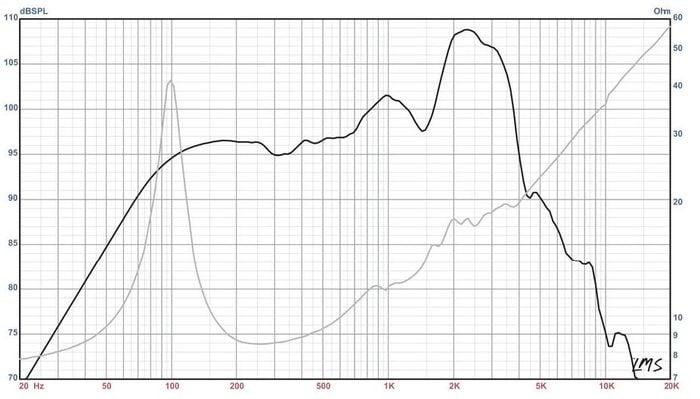Here I'm really wondering.
1. Should OPTs used in a guitar amplifier be deliberately distorting, including a severe HF and/or LF roll-off - in the end, cheaply made?
OR
2. Be as transparent as possible, which means working at a low flux density, high enough bandwidth, low distortion, leaving the later to the driving stages only?
The second makes especially sense, if the amp would be used for a clean channel.
But I would like to hear your opinions, even subjective ones are welcome.
1. Should OPTs used in a guitar amplifier be deliberately distorting, including a severe HF and/or LF roll-off - in the end, cheaply made?
OR
2. Be as transparent as possible, which means working at a low flux density, high enough bandwidth, low distortion, leaving the later to the driving stages only?
The second makes especially sense, if the amp would be used for a clean channel.
But I would like to hear your opinions, even subjective ones are welcome.
I wish I knew how Marshall got their sound. I have designed and build guitar valve amplifiers and they all sound too clean.
I can only guess something Marshall use something being driven hard somewhere. I gave up and used a soft limiter instead which gives a good approximation to an overdriven valve sound for much less money.
I can only guess something Marshall use something being driven hard somewhere. I gave up and used a soft limiter instead which gives a good approximation to an overdriven valve sound for much less money.
Guess it depends on the sort of amp you are trying to make. I had a friend some time ago who designed and built a lot of guitar amplifiers from scratch and he was looking for specific sound qualities which he said were hard to achieve with transformers approaching hifi quality.
I am not aware of all of the things he tried, but under sizing the core, and reducing primary inductance, along with finding the right trade off between leakage inductance and stray capacitance were definitely some of the things he experimented with. Core materials I think also played a role.
I am not aware of all of the things he tried, but under sizing the core, and reducing primary inductance, along with finding the right trade off between leakage inductance and stray capacitance were definitely some of the things he experimented with. Core materials I think also played a role.
No need to deliberately make OTs distort, which in any way would happen at lower frequencies, not the main part of guitar sound by any means, distortion is left to tubes themselves.
OTs need simply to be "adequate", and Guitar duty is easy: lowest frequency is about 80 Hz but more important, it´s attenuated in most "good" amplifiers, sometimes to the extreme, from 6 db down@80/160Hz in Marshall amps to 450Hz in Trainwreck to 650/700Hz in VOX, go figure.
And at the "high" end (what Hi Fi calls high mids), speakers typically have a 6 to 12dB peak somewhere between 2200 and 3500Hz and then drop like a brick at none less than 24dB/oct .

Even a center tapped Power Transformer is "usable", if impedance ratio matches, although that´s an extreme case: it will lack Bass because of lack of primary inductance and will lack treble because of excessive self capacitance and highish leakage inductance ... but even so it will "work".
And with a minimum amount of care, say adequate inductance @ 80 Hz and simple interleaving, say half primary - secondary - half primary you will have a very competent OT.
That said, some famous OT suppliers, such as Schumacher, Drake, Dagnall, Hammond Canada, and above all, Partridge, the "king of OTs" , used only by Hiwatt and Orange because of higher cost, have steadily supplied "better than necessary" OTs simply because they were (still are) suppliers of good quality Hi Fi OTs, they know their job, are fully experienced, know how to do things "right" and they prefer to do things that way.
I very very much doubt Guitar amp manufacturers specify or even less design their own, I bet they ask an established supplier "hi, I need a 3800 ohm to 4/8/16 ohm 100W transformer" and let him supply samples ... which will usually better than needed.
OTs need simply to be "adequate", and Guitar duty is easy: lowest frequency is about 80 Hz but more important, it´s attenuated in most "good" amplifiers, sometimes to the extreme, from 6 db down@80/160Hz in Marshall amps to 450Hz in Trainwreck to 650/700Hz in VOX, go figure.
And at the "high" end (what Hi Fi calls high mids), speakers typically have a 6 to 12dB peak somewhere between 2200 and 3500Hz and then drop like a brick at none less than 24dB/oct .

Even a center tapped Power Transformer is "usable", if impedance ratio matches, although that´s an extreme case: it will lack Bass because of lack of primary inductance and will lack treble because of excessive self capacitance and highish leakage inductance ... but even so it will "work".
And with a minimum amount of care, say adequate inductance @ 80 Hz and simple interleaving, say half primary - secondary - half primary you will have a very competent OT.
That said, some famous OT suppliers, such as Schumacher, Drake, Dagnall, Hammond Canada, and above all, Partridge, the "king of OTs" , used only by Hiwatt and Orange because of higher cost, have steadily supplied "better than necessary" OTs simply because they were (still are) suppliers of good quality Hi Fi OTs, they know their job, are fully experienced, know how to do things "right" and they prefer to do things that way.
I very very much doubt Guitar amp manufacturers specify or even less design their own, I bet they ask an established supplier "hi, I need a 3800 ohm to 4/8/16 ohm 100W transformer" and let him supply samples ... which will usually better than needed.
1. Should OPTs used in a guitar amplifier be deliberately distorting, including a severe HF and/or LF roll-off - in the end, cheaply made?
The reality is that the "cheaply made" part is the driving criteria. Everything else just comes along with it.
I used Ada Depot 80W transformers in 40W hi-fi amps. Fantastic transformers, wide band! Made by Schumakher.
I bought 200 of those when they were available on the surplus market by the thousands for under $20 each. I have taken them apart. Schumaker made car battery chargers, I have one from the same time period. It is a 12 volt 6 amp battery charger. The transformer in the battery charger looks identical to these OPT's, same laminations, same paper construction.
The OPT's are wound with zero interleaving. One half primary is wound on the paper bobbin, then the entire 0-4-8-16 ohm tapped secondary, using progressively smaller wire for each impedance winding, then the second half primary winding is wound over that using a thicker wire than the first half primary to get the two DCR's close.
These "budget" winding techniques and materials will result in higher leakage inductance and capacitance than a HiFi grade OPT, but this is due to the cost constraints, and is not intentional. The spec sheet for my OPT's have lots of mechanical criteria. The only electricals are "80 VA from 80 Hz to 5 KHz, 6600 ohms to 0-4-8-16 ohms." There is just enough iron and copper to satisfy those criteria, so primary inductance is low. These work better as 3300 ohms to 0-2-4-8 ohm transformers.
I bought a bunch of these for building guitar amps. It didn't take long to find that these sounded good, often real good in some HiFi amps. In others, they were sort of lifeless......
The difference turned out to be how the OPT is driven. Drive these OPT's with a good low impedance source capable of fairly high peak currents and get good sound. Run the usual wimpy HiFi tubes and try to fix it with feedback around the OPT, no bueno!
When driven open loop by a pair of 300B's the frequency response at 10 watts is 30 Hz to 20 KHz @ 3db. Saturation effects appear around 20 watts at 30 Hz.
When driven by a pair of large TV sweep tubes with lots of local feedback wrapped around the tubes, but zero GNFB, the frequency response at 10 watts is similar. Maximum power (limited by the power supply and tubes) at 1KHz is 170 watts. Saturation sets in at 45 watts at 41 Hz.
In both cases the amps sound good. In a typical EL84 amp with GNFB, the measured data is worse, and the sound is too.
The whole Fender VS Marshall thing has too many variables to figure out completely. The main players ARE the OPT's, tubes and speakers.
Marshall used EL34's feeding a 4300 ohm OPT from about 400 volts in their "50 watt" amps. Fender used 6L6GC's feeding a 6600 OPT from a higher B+ voltage in their "50 watt" amps. Fender's OPT's were much smaller than Marshall's for the same power level. A 50 watt Marshall made way over 50 watts cranked, while Fender barely made 50 when fed high line voltage. The characteristics of the OEM speakers were grossly different as well.
The frequency range in an electric guitar with standard tuning is 82.4 Hz to 1318.4 Hz if it has 24 frets. Most guitars have 20 to 24 frets. Harmonic energy will reach up into the 5 to 6 KHz range limited by the inductance in the pickup and the capacitance in the cable connecting the guitar to the amp......hence the specs on the cheap guitar OPT's.
Most guitar specific speakers have no response past 5 KHz. Their resonant impedance peak often lies within the guitar's frequency range, usually around 80 to 200 Hz. This makes some low frequency rolloff necessary in the amp, usually undersized coupling and bypass caps compared to a HiFi amp of similar power levels. The response is FAR from flat. 20 dB peaks and valleys are common.
The interplay of the output tubes, OPT and speaker response along with the feedback circuitry (presence control on a Marshall) determine much of the amp's "tone." Super good OPT's are really not needed, since we only want to cover 80 Hz to 5 KHz, and there are so many other nonlinearities present.
(Lots of good stuff which I've deleted)The reality is...
And there's half of another chapter for your book, George!
Last edited:
Just for the fun i build a Fender Champ clone.
I wanted a "large" transformer instead of the very small transformer usually is used for this diy amp. After all you want an amplifier that amplifies and not a amplifier with 5W in the mid frequencies and 0,5W for the low frequencies. Distortion is always a matter of taste but i wanted that the end tubes give the color and not the transformer.
This is the circuit:

This is the frequency response of the transformer with source impedance of 7K:

Frequency response second ecc83 +6v6 without nfb:

the same with feedback:

The compleet amplifier, fronttube, second tube, power tube, transformer and nfb:

As we can see the high frequency is limited by the ecc83 tubes because of the miller effect. Low frequency is limited by the capacitors and also because of the design of the transformer. The transformer can NOT be satured by the power tube (to low power and to less current for the 6v6) and the capacitors will avoid saturation too.
How dos it sound? Excellent, a lot better with a small transformer.
I wanted a "large" transformer instead of the very small transformer usually is used for this diy amp. After all you want an amplifier that amplifies and not a amplifier with 5W in the mid frequencies and 0,5W for the low frequencies. Distortion is always a matter of taste but i wanted that the end tubes give the color and not the transformer.
This is the circuit:

This is the frequency response of the transformer with source impedance of 7K:

Frequency response second ecc83 +6v6 without nfb:

the same with feedback:

The compleet amplifier, fronttube, second tube, power tube, transformer and nfb:

As we can see the high frequency is limited by the ecc83 tubes because of the miller effect. Low frequency is limited by the capacitors and also because of the design of the transformer. The transformer can NOT be satured by the power tube (to low power and to less current for the 6v6) and the capacitors will avoid saturation too.
How dos it sound? Excellent, a lot better with a small transformer.
Last edited:
- Status
- This old topic is closed. If you want to reopen this topic, contact a moderator using the "Report Post" button.
- Home
- Live Sound
- Instruments and Amps
- OPT design for guitar amplifier
 Relocated to Instruments & Amps forum per policy.
Relocated to Instruments & Amps forum per policy.